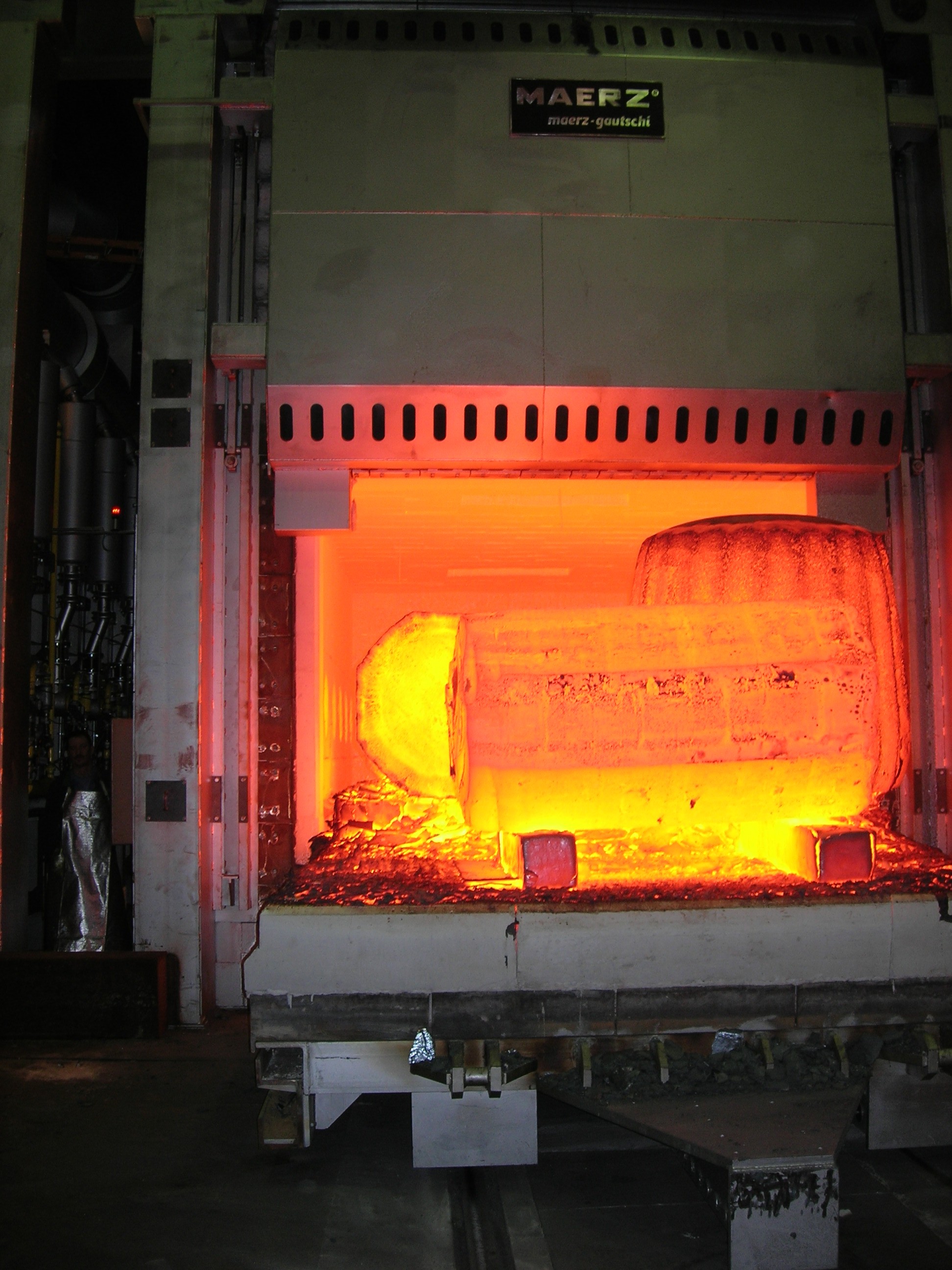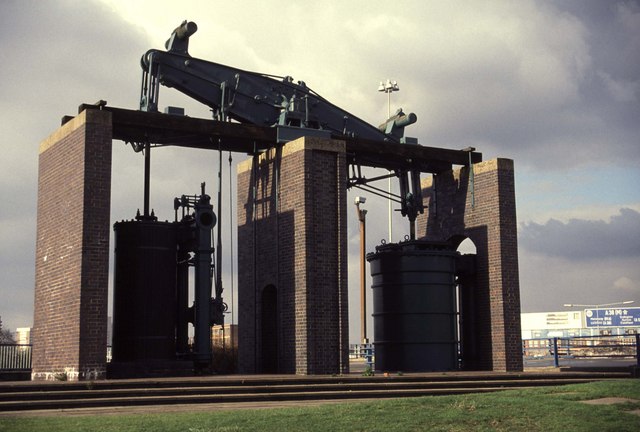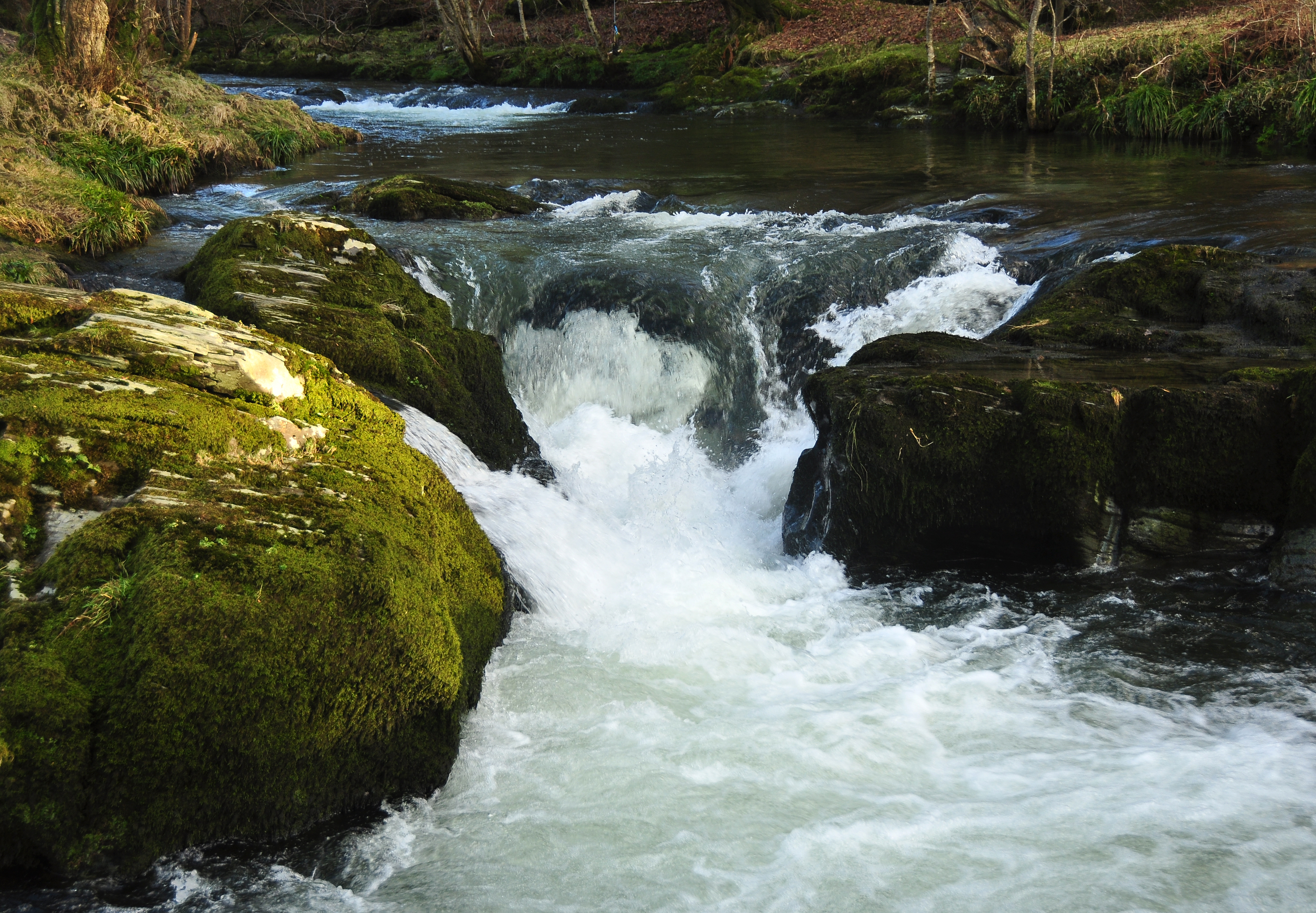|
Blowing House
A blowing house or blowing mill was a building used for smelting tin in Cornwall and on Dartmoor in Devon, in South West England. Blowing houses contained a furnace and a pair of bellows that were powered by an adjacent water wheel, and they were in use from the early 14th century until they were gradually replaced by reverberatory furnaces in the 18th century. The remains of over 40 blowing houses have been identified on Dartmoor. History The blowing house method of smelting tin was probably introduced early in the 14th century to replace the earliest method of smelting which had to be done in two stages – a first smelting probably took place near to the tinworks and the roughly smelted metal was taken to a stannary town to be smelted again to produce the final refined product. Each of these smeltings was taxed separately until 1303 when they were replaced by a single tax on the finished product. It is likely that this tax change was due to the improved smelting process prov ... [...More Info...] [...Related Items...] OR: [Wikipedia] [Google] [Baidu] |
Blowing House Near Black Tor
Blowing may refer to: *Air *Breath *Blowing by a whale, from blowhole (anatomy) Industrial processes *Blowing (glassmaking) *Blowing (textile finishing) *Dry blowing, method to extract gold particles from dry soil without the use of water *Melt blowing Melt blowing is a conventional fabrication method of micro- and nanofibers where a polymer melt is extruded through small nozzles surrounded by high speed blowing gas. The randomly deposited fibers form a Nonwoven fabric, nonwoven sheet product ap ..., fabrication method of micro-and nanofibers through extrusion Other * ''Blowing'' (album), Japanese-language album by Tokio {{dab ... [...More Info...] [...Related Items...] OR: [Wikipedia] [Google] [Baidu] |
Richard Hansford Worth
Richard Hansford Worth (5 November 1868 – 11 November 1950) of Plymouth, Devon was a civil engineer, geologist, archaeologist and writer on Dartmoor. He was the author of numerous papers published by the Devonshire Association some of which became the basis of the book ''Worth’s Dartmoor'' published posthumously. Early life R. Hansford Worth was the son of Lydia Amelia Davies and the geologist, antiquarian and historian Richard Nicholls Worth. He was educated at Plymouth High School for Boys (later called Plymouth College). After leaving school he joined the engineering staff at Great Western Railway at Paddington. He returned to Plymouth in 1890 and set up in private practise as a civil engineer. In 1907 Worth married Miss Annie E. Kingwell of South Brent. Worth adopted many of the interests of his father including a passion for geology, archaeology and Dartmoor. He was a founding member of the Marine Biological Society, a member of the Institution of Civil Engineers and t ... [...More Info...] [...Related Items...] OR: [Wikipedia] [Google] [Baidu] |
Industrial Furnaces
An industrial furnace is a device used to provide heat for an industrial process, typically operating at temperatures above 400 degrees Celsius. These furnaces generate heat by combusting fuel with air or oxygen, or through Electricity, electrical energy, and are used across various industries for applications such as chemical reactions, cremation, Oil refinery, oil refining, and Glass melting furnace, glasswork. The residual heat is expelled as flue gas. While the term industrial furnace encompasses a wide range of high-temperature equipment, one specific type is the direct fired heater, also known as a direct fired furnace or process furnace. Direct fired heaters are primarily used in refinery and petrochemical applications to efficiently transfer heat to process fluids by means of combustion. Unlike other industrial furnaces used in metallurgical furnace, metallurgy or batch ovens, direct fired heaters are optimized for precise temperature control and high thermal efficiency ... [...More Info...] [...Related Items...] OR: [Wikipedia] [Google] [Baidu] |
Tin Mining
Tin mining began early in the Bronze Age, as bronze is a copper-tin alloy. Tin is a relatively rare element in the Earth's crust, with approximately 2 ppm (parts per million), compared to iron with 50,000 ppm. History Tin extraction and use can be dated to the beginnings of the Bronze Age around 3000 BC, when it was observed that copper objects formed of polymetallic ores with different metal contents had different physical properties. The earliest bronze objects had tin or arsenic content of less than 2% and are therefore believed to be the result of unintentional alloying due to trace metal content in the copper ore It was soon discovered that the addition of tin or arsenic to copper increased its hardness and made casting much easier, which revolutionized metal working techniques and brought humanity from the Copper Age or Chalcolithic to the Bronze Age around 3000 BC. Early tin exploitation appears to have been centered on placer deposits of cassiterite. The first eviden ... [...More Info...] [...Related Items...] OR: [Wikipedia] [Google] [Baidu] |
Blowing Engine
A blowing engine is a large stationary steam engine or internal combustion engine directly coupled to air pumping cylinders. They deliver a very large quantity of air at a pressure lower than an air compressor, but greater than a centrifugal fan. Blowing engines are majorly used to provide the air blast for furnaces, blast furnaces and other forms of smelter. Waterwheel engines The very first blowing engines were the blowing houses: bellows, driven by waterwheels. Smelters are most economically located near the source of their ore, which may not have suitable water power available nearby. There is also the risk of drought interrupting the water supply, or of expanding demand for the furnace outstripping the available water capacity. These restrictions led to the very earliest form of steam engine used for power generation rather than pumping, the water-returning engine. With this engine, a steam pump was used to raise water that in turn drove a waterwheel and thus the ... [...More Info...] [...Related Items...] OR: [Wikipedia] [Google] [Baidu] |
Dartmoor Tin-mining
The tin mining industry on Dartmoor, Devon, England, is thought to have originated in pre-Roman times, and continued right through to the 20th century, when the last commercially worked mine (Golden Dagger Mine) closed in November 1930 (though it saw work during the Second World War), and "composite mines" such as those producing tin as a by- product, such as Hemerdon Mine in Plympton continue to operate today. From the 12th century onwards tin mining was regulated by a stannary parliament which had its own laws. Tin is smelted from cassiterite, a mineral found in hydrothermal veins in granite, and the uplands of Dartmoor were a particularly productive area. The techniques used for the extraction of tin from Dartmoor followed a progression from streaming through open cast mining to underground mining. Today, there are extensive archaeological remains of these three phases of the industry, as well as of the several stages of processing that were necessary to convert the ore to ti ... [...More Info...] [...Related Items...] OR: [Wikipedia] [Google] [Baidu] |
River Swincombe
The River Swincombe is a right-bank tributary of the West Dart River that flows through Dartmoor national park in Devon, south-west England. It rises south-east of Princetown, and flows 2 km south-east to Foxtor Mires, where it turns north-east to meet the West Dart near Hexworthy Hexworthy is a hamlet on Dartmoor, in Devon, England. It lies on the West Dart River a mile upstream from Dartmeet. Historically in the parish of Lydford, since 1987 it has been in the civil parish of Dartmoor Forest. Hexworthy has an inn, th .... The first 2 km are known as the Strane River. Some maps show that the source starts north of Nakers Hill and heads north west to the east of Foxtor Mires where it meets the Strane River which (on some maps) is its own river. References External links UK Rivers Guidebook Rivers of Devon Dartmoor 1Swincombe {{England-river-stub ... [...More Info...] [...Related Items...] OR: [Wikipedia] [Google] [Baidu] |
River Walkham
River Walkham is a river whose source is on Dartmoor, Devon, England. It rises in the wide gap between Roos Tor and Great Mis Tor and flows almost due south for approximately leaving the tors and thus National Park behind then south-west for past Woodtown. The river then reaches a village, Horrabridge, with a small compact network of streets mainly on the south or left bank. It receives most of its tributaries which are unnamed headwaters along its south-flowing inception, draining the near side of two series of six tors (peaks) to the west ending in Pew Tor at 320 metres and likewise to the east ending in Leeden Tor at 389 metres (above mean sea level). In absolute distance, west of the village and the same south of the small well-preserved town of Tavistock by a footbridge on the West Devon Way the Walkham joins the Tavy which discharges into the Tamar Estuary north of the Plymouth conurbation after a fast descent around wide hillsides, a few miles south. The confluen ... [...More Info...] [...Related Items...] OR: [Wikipedia] [Google] [Baidu] |
River Yealm
The Yealm is a river in Devon in England that rises above sea level on the Stall Moor mires of south Dartmoor and travels to the sea, passing through Cornwood, Lee Mill and Yealmpton, a mid-sized village with a population of c.2,000 which is its largest settlement, before reaching its estuary which forms a ria bounded on its western side by Wembury. A deep inlet of this ria forms the waterfront to Newton Ferrers and Noss Mayo on its eastern side. Harbour The harbour authority is made up of representatives from the civil parish councils of Wembury, Yealmpton, Brixton and "Newton and Noss". Neighbouring catchment areas It is the river and estuary between the River Plym which discharges at Plymouth and the River Erme which discharges by Meadowsfoot Beach, Mothecombe in Holbeton parish.Grid square ... [...More Info...] [...Related Items...] OR: [Wikipedia] [Google] [Baidu] |
White Tin
White tin is refined metallic tin. It contrasts with black tin, which is unrefined tin ore (cassiterite) as extracted from the ground. The term "white tin" was historically associated with tin mining in Devon and Cornwall where it was smelted from black tin in blowing houses. White tin may also refer specifically to β-tin, the metallic allotrope of the pure element, as opposed to the nonmetallic allotrope α-tin (also known as gray tin), which occurs at temperatures below , a transformation known as tin pest). White tin has tetragonal unit cell. References * * * * White White is the lightest color and is achromatic (having no chroma). It is the color of objects such as snow, chalk, and milk, and is the opposite of black. White objects fully (or almost fully) reflect and scatter all the visible wa ... Mining in Cornwall {{mining-stub ... [...More Info...] [...Related Items...] OR: [Wikipedia] [Google] [Baidu] |
Tin Coinage
In Devon and Cornwall, tin coinage was a tax on refined tin, payable to the Duchy of Cornwall and administered in the Stannary Towns. The oldest surviving records of coinage show that it was collected in 1156. It was abolished by the Tin Duties Act 1838. Method After smelting, the tin was cast into blocks which were taken to the Stannary towns to be proved. Initially irregular in shape, by the 19th century these blocks became standardised as bevel-edged rectangular cuboids weighing . The blocks were marked with a stamp identifying where they had been smelted. At the stannary town the prover, a duchy officer, struck off the corners of the blocks to check the quality of the metal. If proved and the duty paid, a duchy seal was affixed and the blocks permitted to be sold. In the 16th century proving took place only twice a year, at Midsummer and Michaelmas, but afterwards took place quarterly. Under Edmund, 2nd Earl of Cornwall the duty paid in Cornwall was a halfpenny p ... [...More Info...] [...Related Items...] OR: [Wikipedia] [Google] [Baidu] |
Merrivale, Devon
Merrivale (formerly also Merivale) is a locality in western Dartmoor, in the West Devon district of Devon, England. It is best known for the nearby series of Bronze Age megalithic monuments to the south and a former granite quarry. Merrivale hamlet The hamlet, which lies within the civil parish of Whitchurch, is situated at the crossing of the River Walkham on the B3357 (formerly the main Ashburton to Tavistock road), midway between the towns of Princetown and Tavistock. There is an older disused bridge to the north of the modern road. The hamlet is dominated by the spoil tip from the former Merrivale granite quarry (originally known as Tor Quarries),Crossing, William (1912), ''Guide to Dartmoor'', Plymouth: Western Morning News Co Ltd, reprinted with introduction by Brian Le Messurier (rev 1981), Newton Abbot: David & Charles, ) which closed in 1997. The few buildings include houses built originally for quarry workers and the Dartmoor Inn, which sells Merrivale Ale. There wa ... [...More Info...] [...Related Items...] OR: [Wikipedia] [Google] [Baidu] |





